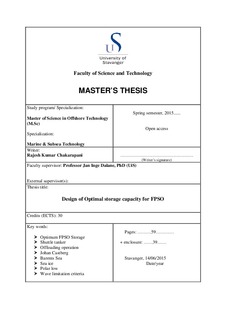| dc.description.abstract | The Floating Production Storage and Offloading (FPSO) concept is a ship shaped production
platform frequently used on the Norwegian Continental Shelf (NCS). One of the main
advantages of a FPSO is that the produced oil can be stored in the cargo tanks and offloaded
to shuttle tankers by tandem offloading. Tandem offloading means that a loading hose from
the stern of the FPSO is connected to the bow of the shuttle tanker. The shuttle tankers will
then transport the oil to an oil terminal at shore or directly to the market.
Tandem offloading is a safety critical and weather sensitive operation. Adverse weather
conditions such as wave heights, polar lows, sea ice, etc., influences the offloading operation
considerably. The shuttle tankers will normally be allowed to start the operation, if the
significant wave height is below 4,5m and stop if the wave height increases to above 5,5m. A
small storage capacity on the FPSO could lead to multiple offloading operations resulting in
low regularity for the shuttle tanker operation and transportation. The storage capacity on the
FPSO should allow for a full load for the shuttle tanker and also have some margin in order to
include uncertainties in the offloading and transportation chain. Typical shuttle tankers have
capacities in the range of 550.000 – 850.000 barrels.
The oil companies have long experience with tandem loading on the NCS. However, offshore
field developments are now moving further north into the Barents Sea and we are in subarctic
area. The Goliat and Johan Castberg projects are example on such developments. These
new areas have challenges related to sub-arctic climate and weather conditions. There is also
a long transportation route, if the oil should be transported directly to the market in Europe. A
fleet of dedicated purpose built shuttle tankers may be needed for a field development in this
area.
The cost related to offloading and transportation of oil is significant and the following three
main questions need to be addressed;
1. How large should be the FPSO storage capacity in order to secure sufficient
offloading regularity?
2. How many shuttle tankers are needed and what should be the capacity in order to
ensure sufficient regularity of the transportation?
3. How significant wave height, sea ice & polar lows influence the FPSO storage
capacity?
For commercial, safety and efficiency reasons, these three questions need to be considered in
early phase of the design. The optimal answer depends on many parameters;
Oil production profile for the FPSO
Actual weather condition and weather limitations criteria
Connecting and disconnecting time
Pump capacity for the oil transfer
Sailing route and distance to the market
Regularity requirements
Shuttle tankers capacity
Cost for FPSO storage
Using Johan Castberg oil production rate, typical shuttle tanker capacities, wave limitation
criteria, time taken by shuttle tankers to travel on 1.5m thick sea ice and 48 hours duration
polar lows in the vicinity of FPSO, this dissertation intend to optimize the storage capacity
for the FPSO.
It is assumed that produced oil from Johan Castberg field is transported using shuttle tankers
to Murmansk oil terminal located in Russia. The reason for assuming a specific field and oil
terminal is to gather input parameters, such as production rate, hindcast data, maritime
distance in ice infested waters etc. The case study is performed with shuttle tanker capacity of
850,000 bbls. Otherwise, the adopted concept in this dissertation will be general i.e., to serve
the wide variety of situations and geographical locations.
In conclusion, the entire exercise undergone in this dissertation is presented as a model, in a
“User friendly” Excel spread sheet format for future use. | nb_NO |
